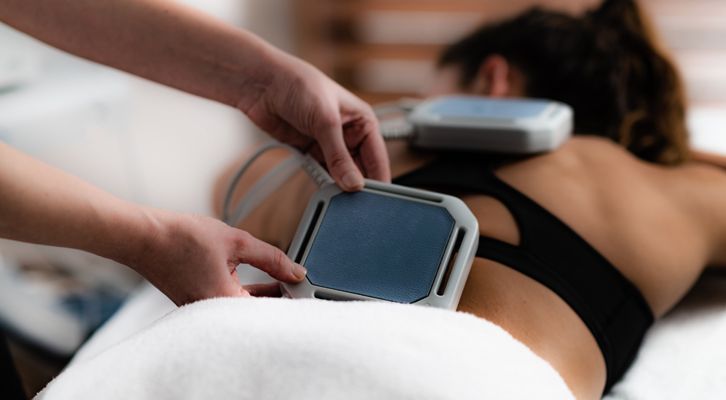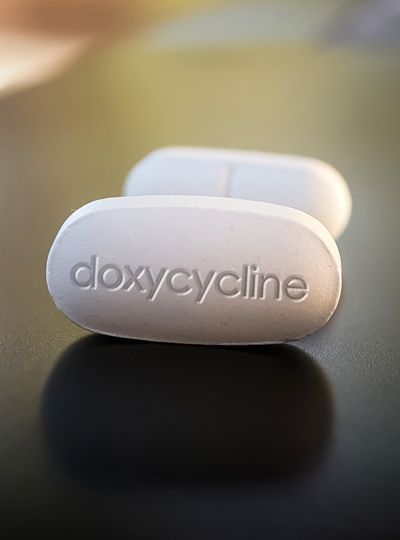Biomagnets for Treating Lyme Disease NYC - Marc Bystock L.Ac.
"Since magnets can change the electric potential within biological tissue, magnets can reestablish a disrupted balance of bio-electric potential. In other words, magnets can potentially turn Lyme diseased tissue back to a healthy state.
-Marc Bystock L.Ac.
Natural Lyme Disease Treatments with Biomagnetic Therapy by Marc Bystock L.Ac. NYC Acupuncturist in Midtown Manhattan, NY 10016. Free Consultation.
Lyme disease numbers are on the rise and have doubled in recent years. According to the Centers for Disease Control (CDC), Lyme disease affects over 476,000 individuals annually. While taken at face value, that's a significant number. However, the truth may be that the real numbers are surprisingly higher.
Immature deer ticks, called nymphs, are common vectors for Lyme disease. They are about the size of a pinhead. Nymphs pick up bacteria when feeding small rodents, such as mice and rats infected with B. burgdorferi. Because of their minute size, their detection is challenging. It remains possible that Lyme and its coinfections may be transmitted through other means, such as other insect vectors.
Lyme disease is more complicated to diagnose than many other disorders. The misdiagnosis of Lyme disease is common. Lyme is often called the great imitator because there are so many Lyme symptoms it can easily be confused with many other disorders.
The many symptoms of Lyme disease include:
- Facial paralysis
- Fatigue
- Blurry vision
- Headaches and migraines
- Arthritis joint and muscle pain
- Cardiac issues like heart palpitations and irregular heartbeat
- Dizziness, vertigo, shortness of breath
- Numbness, tingling, shooting pains
- Cognitive issues, memory problems, anxiety and depression
- Insomnia
Laboratory testing for Lyme and its coinfections does not have an excellent record. According to Lymedisease.org, 56% of patients with Lyme disease test negative using the two-tiered testing system recommended by the CDC. That means that a lot of people with Lyme do not get properly diagnosed and treated. Lyme Borrelia rapidly leaves the blood and goes into the lymph nodes and the tissues after the initial transmission by the tick bite. Furthermore, blood tests for early Lyme disease have low sensitivity rates.
Traditional Medicine's Treatment for Lyme Disease
The standard of care for early uncomplicated Lyme disease recommended by the CDC is 21 days of doxycycline. Doxycycline is an oral antibiotic usually prescribed twice daily. While this strategy may work for some patients when early detection has been observed, many cases are not resolved, leading to more chronic Lyme severity.
Chronic Lyme is problematic for traditional medical treatment for several reasons:
- The test results were false negative.
- The patient was misdiagnosed and not given proper treatment.
- It is treated with the use of prolonged antibiotics, which can lead to severe health adversity and antibiotic resistance.
- Inflammation, pain, and other symptoms usually worsen over time, causing greater complications that may go unresolved.
Most Lyme patients have higher-than-normal levels of inflammation in their bodies. Lyme disease can trigger a significant acute and chronic inflammatory process in the patient. The typical erythema migrans bullseye rash that approximately 30-40 % of Lyme patients experience initially due to a tick bite is an inflammatory reaction to the bacteria. Lyme disease causes inflammatory reactions through several mechanisms, including activating the innate and adaptive immunity systems.
In many Lyme patients, the disorder progresses to include Lyme arthritis. Any joint in the body may be affected, but mostly larger joints such as hips, knees, and elbows. Borrelia can degrade and break down cartilage and the extracellular matrix, leading to joint erosion and arthritis and causing chronic episodes of inflammation. The inflammation worsens with the release and increase of proinflammatory cytokine markers, making pain levels increasingly uncomfortable.
Another area of Lyme disease that many of my patients experience is neuroinflammation or an inflamed brain. The symptoms usually are felt as cognitive decline, brain fog, insomnia, anxiety, and depression. Borrelia and its coinfections can circulate to go past the blood-brain barrier from a few minutes to days after the initial infection. The brain is a protected area. Once a pathogen intruder infiltrates this space, the brain responds with inflammation. Because the immune system is different in the brain than the rest of the body, it can be more difficult to extinguish the inflammation once it has begun.
Holistic Treatment for Lyme Disease with Biomagnet Therapy
The basic concepts of Biomagnetic therapy or Biomagnetic paired therapy were first discovered by Dr. Broeringmeyer, medical director of NASA, in the 1970s. The complete Biomagnetic system was created later in 1988 by Dr. Issac Goiz Duran, a student of Dr. Broeingmeyer. The system involves the placement of polar opposite magnets on the body at very specific points to achieve a change towards normalization in body pH.
It began with the discovery made by Dr. Richard Broeringmeyer at NASA. He discovered that all astronauts shared one physical attribute upon return to Earth. One of the astronauts' legs was shorter by about 2 cm. When he sought out the cause of this anomaly, he found that it was due to a lack of the Earth's magnetic field while suspended in outer space.
Dr. Broeringmayer discovered that the body's pH (acidity/alkalinity) was linked to the influence of the magnets (magnetic field) exerted on the body.
He determined a cause-and-effect situation between the pH states of certain body parts and their functions as they relate to health. Therefore, he concluded that magnetic polarization leads to pathological states of disease.
Since magnets can change the electric potential within biological tissue, he concluded that magnets can reestablish a disrupted balance of bio-electric potential. In other words, magnets can potentially turn Lyme diseased tissue back to a healthy state. The Lyme Biomagnetic treatment is specifically used to treat patients with Lyme disease, their coinfections, and associated toxins and imbalances.
Because magnets help to restore the body's pH and break up the genetic resonance that pathogens may have, they begin to lose their pathogenic capacity. The therapeutic placement of biomagnetic polar opposite pairs makes the biological environment inhospitable for Borrelia, which has many coinfections. This creates an unfavorable environment for pathogens to thrive. Normalizing the body's pH and bioelectrical properties stimulates the immune system, increasing its ability to find and destroy Lyme and its many coinfections.
The lymph and biodetoxification systems become stimulated by placing biomagnetic pairs on the body. Magnets can target specific organs like the liver, kidneys, bladder, and gastrointestinal tract, maximizing their potential activity. This increase in momentum removes more toxicity from the body, permitting the immune system to perform at a higher level.
The biomagnetic therapy system incorporates applied kinesiology (functional muscle and nerve testing) to determine the exact location of the biomagnets' placement on the body. Testing is necessary to understand the various Lyme coinfections, whether bacteria, viruses, fungi, or parasites. Biomagnetic therapy can help the body to alleviate the many symptoms related to Lyme, such as joint pains, headaches, neurological disorders, brain fog, fatigue, insomnia, anxiety, and autoimmune reactions, by addressing the root causes. Biomagnetic therapy for Lyme may be used along with other modalities, including acupuncture and herbs, to support the patient with a comprehensive approach.
How Acupuncture Helps Treat Lyme Disease
Acupuncture may be incorporated along with Biomagnet therapy to treat patients with Lyme disease. This combination adds a variety of benefits:
- Acupuncture can lower inflammation and joint pain in the body, a major complaint associated with Lyme disease. Stimulating acupuncture meridian points on the body can decrease inflammatory markers.
- Acupuncture can boost energy levels and combat fatigue. Most Lyme patients describe fatigue as one of their main disturbances.
- Acupuncture can alleviate pain. Lyme disease causes pain, including joint pain, headaches, muscle aches, and neurogenic pain. Acupuncture stimulates endorphins, enkephalins, and neurotransmitters such as dopamine and serotonin to reduce pain and regulate the autonomic nervous system.
- Acupuncture works with Biomagnet therapy to help detoxify the body by moving blood, lymph, and fluids and stimulating the liver.
- Acupuncture improves both sleep and mood. Acupuncture helps to regulate sleeping patterns and reduces stress and anxiety.
- Acupuncture can strengthen body immunity by increasing the production of red and white blood cells, including T-cells. When activated, white blood cells and T-cells reduce Lyme titer levels.
Finally, by combining Biomagnetic and acupuncture treatments with the proper herbs and supplements, a holistic and comprehensive approach is attained to:
1. Lower the titer levels of Borrelia and its coinfections.
2. Support the body's detoxification pathways that remove dead pathogens and other waste material.
3. Lower inflammation.
4. Rid the body of pain.
5. Boost the immune system.
6. Strengthen and energize the body.
7. Manage and maintain the body by restoring it to its former vigor.
Contact NYC Acupuncturist Marc Bystock L.Ac. for Natural Lyme Disease Treatments in NYC
My name is Marc Bystock. I'm a leading New York City acupuncturist and a Biomagnetic practitioner with many years of experience. I know just how debilitating Lyme can be. I've helped many Lyme patients who suffered from severe symptoms.
If you have been diagnosed with Lyme disease or if you have any of the symptoms named above, please contact me as soon as possible to discuss if the holistic acupuncture and Biomagnetic protocol is right for you!
Please contact me today!







